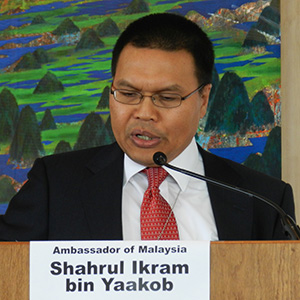
VCDNP Partners with the Integrated Support Center for Nuclear Nonproliferation of the Japanese Atomic Energy Agency, and the Permanent Mission of Japan in Vienna to Host an Event on Cooperation Among Nuclear Security Centers of Excellence in Asia

On July 3, 2013, VCDNP co-organized a workshop on Nuclear Security Centers of Excellence in Asia with the Integrated Support Center for Nuclear Nonproliferation and Nuclear Security (ISCN) of Japan and the Permanent Mission of Japan in Vienna.Elena Sokova, Executive Director of the VCDNP, moderated the discussion between panellists from the Republic of Korea, China, and Japan and commentators from the United States, the European Commission, and the International Atomic Energy Agency.Ambassador Toshio Ozawa of Japan welcomed the audience and invited theAmbassador of Malaysia, H.E, Shahrul Ikram bin Yaakob, to give a keynote speech.
Ambassador Yaakob focused his remarks on human capacity building in the area of nuclear security as many countries in Asia expand or embark on nuclear power programs. He emphasized the need to develop skills across all levels of stakeholders including government, regulators, and operators in order to meet the demand of expertise in nuclear safety, security, and safeguards. Ambassador Yaakob underlined that in order to truly create synergies in nuclear security education and training all involved parties must be willing to share expertise, allocate resources, and provide complementary rather than redundant training.
Dr. Kwan-Kyoo Choe, Director of the International Nuclear Non-proliferation and Security Academy (INSA) at the Korea Institute of Nuclear Non-proliferation and Control (KINAC), opened the panel discussion. Dr. Choe emphasized INSA's educational focus on physical protection, export controls, and safeguards. He was also proud to announce that an INSA education facility will be complete by February 2014 and the first training on the new grounds will begin the following month. INSA hopes to produce 200 experts per year in domestic safeguards and over 1,000 experts per year in security and protection.
Dr. Xu Zhenhua, Assistant Director General State Nuclear Security Technology Center of China, stated that nuclear energy will be increasingly important in the coming decades for his country. To meet this demand, China has engaged in extensive international nuclear security cooperation with the goal of strengthening the global nuclear security regime and combatting proliferation and nuclear terrorism. China's State Nuclear Security Technology Center has been tasked with management and operation of the Beijing-based Center of Excellence that will be complete within a year. The Center's current program is designed to meet the domestic demand in nuclear security specialists.
Completing the panel presentations was Dr. Masao Senzaki, Director of the ISCN at the Japanese Atomic Energy Agency. Dr. Senzaki echoed points made in the keynote address and stressed the need to build capacity through nuclear security courses. From 2011 to the present, the ISCN has trained 579 participants in 19 courses on nuclear security, safeguards, and nonproliferation. Dr. Senzaki also suggested several areas for cooperation such as information sharing about the focus of the training and about scheduling various courses, as well as exchanges of instructors and observers among the centers of excellence in China, the Republic of Korea, and Japan, as well with other centers in Asia to facilitate consistency in the content and methodology, improve skills, and receive feedback.

The commentators included the United States Department of Energy's International Nuclear Security Program leader Ms. Martie Larson, Mr. Adriaan Van der Meerof the European Commission for Development and Cooperation, and Head of the Program Support Group of the Office of Nuclear Security at the IAEA, Mr. Tim Andrews. The three commentators applauded Asia for being a leader in international nuclear education and training as well as their support for the Centers of Excellence. They fully shared the goal of finding and nurturing synergies, cooperation, and coordination among the three centers and among all centers of excellence, particularly at the regional level.


